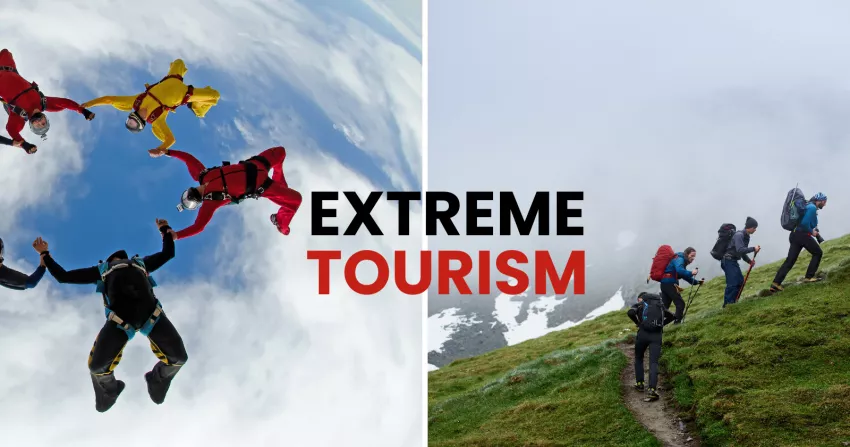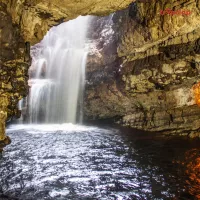Extreme Tourism: The Ultimate Adventure with High Risks

Extreme tourism refers to travel experiences that involve physically demanding, high-risk adventures. Activities typically take place in challenging environments such as remote wilderness, extreme weather conditions, or hazardous terrains. Participants often seek the rush of pushing beyond physical and psychological boundaries.
Popular Extreme Tourism Activities
- Base Jumping
Base jumping is an extreme sport that involves leaping from fixed objects, such as cliffs, buildings, or bridges, with a parachute to break the fall. The term "BASE" stands for the four categories of objects participants jump from: Buildings, Antennas, Spans (bridges), and Earth (cliffs). Unlike skydiving, base jumpers start from a much lower altitude, usually just a few hundred to a thousand feet above the ground, making the jump more dangerous.
The thrill of base jumping comes from the short freefall and the immediate need to deploy the parachute, often within seconds of the leap. The proximity to the ground creates a sense of heightened risk and excitement, and the rapid descent makes it a heart-stopping experience.
Base jumping is considered one of the most dangerous extreme sports, with a high fatality rate. The low altitude gives jumpers little room for error or malfunction, and variables such as wind conditions, obstacles, and gear performance can significantly impact safety. Even experienced jumpers face the constant risk of injury or death.
Due to its dangers, base jumping is illegal in many areas, but popular spots include Norway’s Kjerag cliffs, the Angel Falls in Venezuela, and skyscrapers in Kuala Lumpur, Malaysia.
- Skydiving
Skydiving is one of the most popular extreme tourism activities, offering participants an exhilarating experience of free-falling from an airplane at high altitudes. Jumpers typically exit the aircraft from a height of 10,000 to 15,000 feet, plummeting towards the earth at speeds of 120 mph or more before deploying a parachute to slow down for a safe landing.
The appeal of skydiving lies in the combination of adrenaline rush and the unique perspective of seeing the world from thousands of feet in the air. The initial freefall offers an intense, heart-pounding thrill, while the parachute descent allows time to soak in breathtaking views and experience a sensation of floating.
While skydiving is generally considered safe when done with proper equipment and under the guidance of certified instructors, it is still a high-risk activity. Malfunctions in parachutes, sudden changes in weather, or mistakes in the jump process can lead to serious injury or even death. Many skydivers undergo extensive training and make tandem jumps with experienced instructors to minimize risks.
Popular skydiving destinations include New Zealand, Switzerland, and Dubai, where stunning landscapes add to the experience, making it a must-try adventure for thrill-seekers around the world.
- Mountain Climbing
Mountain climbing, also known as mountaineering, is an extreme adventure that involves ascending the world’s highest and most challenging peaks. It requires a mix of physical endurance, technical skill, and mental toughness. Climbers often face harsh weather conditions, altitude sickness, and difficult terrain while scaling peaks like Mount Everest, K2, or Denali.
One of the primary appeals of mountain climbing is the sense of achievement that comes from reaching a summit after enduring days or even weeks of strenuous effort. Climbers must navigate ice fields, rocky outcrops, and sometimes extreme temperatures, all while carrying their supplies and managing their energy. The journey itself can be a deeply personal challenge, testing both the body and mind.
Despite its rewards, mountain climbing is fraught with risks. Altitude sickness can cause nausea, dizziness, or even death if not treated. The danger of avalanches, rock falls, and sudden weather changes can put climbers in life-threatening situations. Proper training, experience, and gear are essential for mitigating these risks, but even then, fatalities are not uncommon.
Mountain climbing is a popular extreme tourism activity in the Himalayas, the Andes, and the Alps, attracting adventurers seeking to conquer nature’s highest and most dangerous landscapes.
- Scuba Diving in Caves
- White-Water Rafting
White-water rafting is an extreme water sport where participants navigate a river's fast-moving rapids in an inflatable raft. The challenge comes from the unpredictable nature of the river, which can include steep drops, strong currents, and obstacles such as rocks and logs. The thrill of white-water rafting is in the constant battle against the natural forces of the river, where teamwork and quick reflexes are essential for a safe journey.
Rivers are typically classified by difficulty, from Class I (easy) to Class VI (extremely dangerous and nearly impassable). Rafters may face anything from gentle waves to turbulent, crashing waters that can flip rafts or throw participants into the river.
While white-water rafting offers an exhilarating experience, it also carries risks, including drowning, hypothermia, or injury from collisions with rocks or other debris. Wearing proper safety gear, such as helmets and life jackets, and rafting under the supervision of experienced guides can reduce these risks.
Some of the most famous white-water rafting destinations include the Colorado River in the Grand Canyon, the Zambezi River in Africa, and the Ganges River in India. These locations offer a mix of challenging rapids and breathtaking scenery, attracting adventure tourists from around the world.
- Bungee Jumping
Bungee jumping is a high-adrenaline activity where participants leap from a platform, bridge, or other elevated structure while attached to a long elastic cord. The cord stretches as the jumper falls, then recoils, bringing them back up before oscillating until they come to a stop. The thrill comes from the initial freefall and the sensation of weightlessness before the cord pulls them back.
Unlike other extreme sports that require extensive training or technical skills, bungee jumping is relatively accessible to the average tourist. Most jump sites provide safety equipment and guidance, making it a popular choice for those seeking a quick thrill.
However, bungee jumping still carries risks. Equipment failure, miscalculations in cord length, or improper harnessing can lead to serious injury or death. Most accidents occur due to human error or equipment malfunction, though these are rare in professional setups. Despite these risks, the sensation of plummeting toward the earth, followed by the relief of the cord catching, makes bungee jumping a memorable experience.
Popular bungee jumping locations include the Kawarau Bridge in New Zealand, the Victoria Falls Bridge between Zimbabwe and Zambia, and the Bloukrans Bridge in South Africa, which is the world’s highest commercial bungee jump at 216 meters.
Why Do People Choose Extreme Tourism?
People are drawn to extreme tourism for several reasons, ranging from the thrill of adventure to the desire for personal growth. The most prominent factor is the adrenaline rush. Extreme tourism activities, such as skydiving, bungee jumping, or mountain climbing, trigger a powerful surge of adrenaline, leading to an intense feeling of excitement and exhilaration. This burst of energy makes participants feel more alive and invigorated, which is highly appealing for those seeking an unforgettable experience.
Another major motivator is the challenge. Many individuals participate in extreme tourism to push their physical and mental limits. Whether it's scaling a difficult peak or navigating white-water rapids, these activities test endurance, resilience, and problem-solving skills. The sense of accomplishment that follows overcoming such daunting challenges provides a deep sense of personal satisfaction and self-growth. For some, this is not only about testing their strength but also about overcoming fears and achieving something they never thought possible.
Extreme tourism also offers a unique escape from routine. In a world where daily life can become monotonous, extreme tourism provides a break from the ordinary. It transports participants to new and often remote environments, allowing them to disconnect from everyday stress and immerse themselves in a raw, natural setting.
Moreover, extreme tourism allows travelers to experience the world differently. Whether it’s jumping off cliffs in Norway or rafting down the Zambezi River, these activities offer a fresh perspective on natural landscapes, fostering a deeper connection to the environment.
Finally, many choose extreme tourism for the bragging rights. Successfully completing dangerous adventures not only builds self-esteem but also provides stories and experiences that can be shared with others, enhancing social status among peers.
The Risks Involved in Extreme Tourism
Extreme tourism carries significant risks due to the dangerous nature of the activities involved. One of the primary risks is physical injury. Participants in high-adrenaline sports like skydiving, base jumping, or mountain climbing face the constant threat of accidents. Broken bones, concussions, or even life-threatening injuries can occur if equipment fails or conditions change unexpectedly. In some cases, extreme sports have fatality rates up to 10 times higher than traditional activities.
Environmental risks are also a major concern. Adventure activities often take place in remote or hazardous environments, such as mountain ranges, deep oceans, or dense jungles. Factors like avalanches, rockfalls, extreme weather, or encounters with wildlife can pose serious dangers, often in areas far from immediate help.
Another risk is health-related. High-altitude climbing can lead to altitude sickness, which can cause nausea, dizziness, or even death if left untreated. Similarly, dehydration, hypothermia, or sunstroke are common threats in extreme conditions.
Finally, lack of preparedness or improper training can exacerbate these risks. Without the right skills, equipment, or safety measures, participants increase their chances of injury or fatal outcomes. While extreme tourism offers thrilling experiences, the dangers are real, and proper precautions are essential to minimize risks.
The Role of Extreme Tourism in Global Travel
Extreme tourism has been steadily growing in popularity, contributing significantly to the global travel market. In 2023, the adventure tourism market was valued at $366.7 billion and is expected to grow by 15.2% from 2023 to 2030 . Popular destinations for extreme tourism include Nepal for trekking, Iceland for glacier hiking, and New Zealand for skydiving.
Safety Tips for Extreme Tourists
While the thrill is the main attraction, safety is paramount in extreme tourism. Here are some key precautions:
- Training: Ensure you are physically prepared and trained for the activity.
- Certified Guides: Always rely on certified, experienced guides who know the terrain or sport.
- Right Gear: Wear the appropriate gear for safety and survival.
- Health Insurance: Travel insurance that covers extreme sports is a must.
- Emergency Plans: Have contingency plans in case things go wrong, especially in remote areas.
Is Extreme Tourism for You?
Conclusion

Akshita Gera

Tell us about your trip

Get Custom quotes from top agents.

Choose the package you like
• Velankanni • Lataguri • Parwanoo • Makarska • Srinagar • Cherrapunjee • Ahmedabad • Baa Atoll • Chiang Rai • Narnaul • Sibsagar • Gaumukh • Da Nang • Changlang • Almora • Rasdhoo Island • Guntur • Langkawi • Nathdwara • Nuh • Dudhwa National Park • Nice • • Nelliyampathy • Phuket • Prague • Punakha Dzong • Tranquebar • Yingkiong • Bokaro Steel City • Vaishno • Dantewada • Anantnag • Sandakan • Tirunelveli • Kumarakom • Kurukshetra • Bhuj • Achampet • Bardhaman • Ramnagar • Anantapur • Andaman • Chopta • Mukteshwar • Sikar • Kargil • Uttarkashi • Munich • Lucerne
Kashmir Tour Packages Andaman Tour Packages Kerala Tour Packages Shimla Tour Packages Manali Tour Packages Sikkim Tour Packages Uttarakhand Tour Packages Rajasthan Tour Packages Chardham Tour Packages Gujarat Tour Packages Rameswaram Tour Packages Gangtok Tour Packages Goa Tour Packages Jaipur Tour Packages Ooty Tour Packages Jim Corbett Tour Packages Mussoorie Tour Packages Kanyakumari Tour Packages Meghalaya Tour Packages Ladakh Tour Packages
Dubai Tour Packages Bali Tour Packages Singapore Tour Packages Thailand Tour Packages Maldives Tour Packages Bhutan Tour Packages Vietnam Tour Packages Mauritius Tour Packages Nepal Tour Packages Europe Tour Packages Sri lanka Tour Packages Turkey Tour Packages Malaysia Tour Packages Azerbaijan Tour Packages


 May
May June
June July
July August
August September
September October
October November
November December
December January
January February
February March
March April
April



























